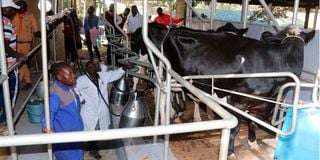Why doctors need to be aware of concurrent illnesses

Cows at a milking pen during the opening of the Nairobi International Trade Fair on Ngong Road on September 26, 2022. Many diseases affect milk yields.
The most common case reports I receive are of an animal having one set of disease symptoms.
When I visit the farm, I confirm a single disease process, treat and the patient in a majority of the cases recovers uneventfully.
The situation can sometimes be complicated and the animal appears not to be recovering from the treatment.
In such cases, I have to think if I missed some other disease processes, if the medicine given was inappropriate or whether the disease agent is resistant to the drugs administered to the animal.
When a number of illnesses occur in an animal at the same time, we call that concurrent diseases.
The doctor can fail to make a complete diagnosis due to being not very keen, signs of one disease being masked by those of another or some of the illnesses being in the incubation period when they do not show signs.
The likelihood of concurrent diseases should always be in the doctor’s mind when attending even to cases that look well presented.
A few weeks ago, I had an interesting case presented over the phone by Murage, one of the paravet animal health service providers I work with in Murang’a County.
Murage said he had treated a newly-calved cow for three-day sickness.
The animal had been reported unable to stand but it looked fine.
Temperature drop
The farmer said the temperature had been 41 degrees Celsius in the morning but when Murage visited at 11 am, he found it was 39.9.
The paravet wondered why the temperature had dropped without treatment. Could it be that the farmer had misread the temperature?
Murage said he had treated the animal with anti-inflammatories and tetracycline long-acting antibiotic.
He advised the farmer to give the cow a few days and it would stand up. The animal stood on the fourth day but did not regain its appetite.
Murage was called again and found the cow had a fever of 41.5 degrees Celsius.
The legs were swollen below the knee and carpal joints. The cow was reluctant to walk and milk yield had dropped drastically.
The lymph nodes were swollen but there was no salivation or tearing of the eyes.
It was at that point that Murage called again to say the case was behaving abnormally.
Once a three-day sick cow stands, it is supposed to regain appetite, increase milk yield and walk without a problem.
I instructed Murage to check the inside and outside of the vulva for any sign of disease.
He reported reddening of the internal vulva surface and two dark button-like nodules on the skin.
I confirmed to him that he was dealing with a concurrent infection of three-day sickness and mild lumpy skin disease.
I instructed Murage to repeat the anti-inflammatory treatment but not the antibiotic.
I also told him to instruct the animal owner to wash it with a good anti-parasite chemical of the pyrethroid family twice per week to control the biting flies which spread the viruses that cause the two diseases.
Combination of diseases
Two days later, Murage reported the cow had recovered and the milk yield had increased to just below the production before the onset of the illnesses.
I keep saying diseases have unexpected ways of surprising a doctor. I have never seen a combination of the two diseases in my many years of practice. I have seen them occurring individually.
Both diseases are spread by biting insects, especially mosquitoes.
That explains the reason they tend to occur at the onset of the wet season when flies multiply heavily.
Lumpy skin disease (LSD) is caused by a pox virus inducing high fever, swelling of lymph nodes, loss of appetite and the eruption of hard round nodules on the skin and mucous membranes.
The full-blown disease is severe and often fatal.
Mild disease is characterised by a few small nodules mainly on the vulva, swelling of legs and lymph nodes and a high fever of up to 42 degrees Celsius.
The temperature remains high until the body inactivates the virus.
Mild LSD occurs in cattle that are routinely vaccinated against the disease.
Most vaccinated animals show no signs of infection even though the virus may unsuccessfully attempt to infect the cow.
The ephemeral fever virus causes ephemeral fever or three-day sickness in cattle.
Farmers suddenly find apparently healthy animals and in good body condition unable to stand.
Even if untreated, the animal may just stand up and walk after eight hours to seven days, with an average of three days.
This is the reason for naming it the three-day sickness.
Most animals show poor appetite, inability to stand, heavily reduced milk yield and sometimes drooling and abortion.
There may be hard dung due to paralysis of the stomach. The animal looks anxiously at people it knows, as though asking for help to stand.
Temperature is elevated to between 40 and 41 degrees Celsius and may keep fluctuating.
This explains the observation of discrepancy in the temperature reading by Murage and his farmer client.
In both cases, antibiotics and anti-inflammatories are used to reduce the impact of the virus on the body but there is no specific treatment.
Animals recovering from three-day sickness become immunised for life.
Both diseases are prevented by controlling biting flies. However, LSD is effectively controlled by diligent vaccination.





